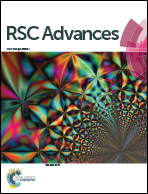Heterogeneous catalytic wet peroxide oxidation of simulated phenol wastewater by copper metal–organic frameworks
Abstract
Two different porous copper metal–organic frameworks (Cu-MOFs) named as Cu3(BTC)2 and Cu(BDC) were synthesized and applied as heterogeneous catalysts for the catalytic wet peroxide oxidation (CWPO) of simulated phenol wastewater (100 mg L−1). The materials were characterized using X-ray Powder Diffraction (XRD), Fourier Transform Infrared (FT-IR) spectroscopy, Scanning Electron Microscopy (SEM), and Energy Dispersive X-ray (EDX) spectroscopy. By comparison, the Cu(BDC) exhibited a better catalytic degradation performance. and was selected for further experiments. Several parameters including temperature, H2O2 dose, catalyst dose and initial pH of the phenol wastewater which could affect the catalytic degradation efficiency by the Cu(BDC) were investigated. Under optimum conditions, a phenol conversion of 99% and a COD (Chemical Oxygen Demand) removal of 93% were achieved. The degradation of phenol solutions of different concentrations (100 to 1000 mg L−1) was also carried out. No matter whether a low or high concentration of the phenol solution was used, satisfactory results with a phenol conversion of 99% and a COD removal of over 90% were obtained. After being reused twice, the Cu(BDC) still maintained a good catalytic performance with a phenol conversion of 99% and a COD removal of over 85%. Like other copper catalysts, the mechanism of the degradation process was a hydroxyl radical mechanism. The leaching of Cu2+ was also monitored by Inductively Coupled Plasma-Atomic Emission Spectroscopy (ICP-AES) and a negligible release of copper (7 ppm) was observed. Overall, Cu-MOFs could be promising heterogeneous catalysts for the catalytic oxidation of phenol with H2O2 as the oxidant.


 Please wait while we load your content...
Please wait while we load your content...